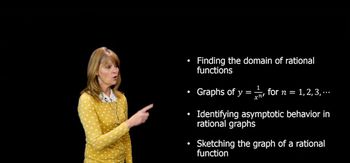Table of contents
- 0. Review of Algebra4h 16m
- 1. Equations & Inequalities3h 18m
- 2. Graphs of Equations43m
- 3. Functions2h 17m
- 4. Polynomial Functions1h 44m
- 5. Rational Functions1h 23m
- 6. Exponential & Logarithmic Functions2h 28m
- 7. Systems of Equations & Matrices4h 6m
- 8. Conic Sections2h 23m
- 9. Sequences, Series, & Induction1h 19m
- 10. Combinatorics & Probability1h 45m
5. Rational Functions
Introduction to Rational Functions
Problem 33
Textbook Question
Match the rational function in Column I with the appropriate descrip-tion in Column II. Choices in Column II can be used only once. ƒ(x)=(x^2-16)/(x+4)
 Verified step by step guidance
Verified step by step guidance1
<Factor the numerator of the rational function \( f(x) = \frac{x^2 - 16}{x + 4} \).>
<Recognize that \( x^2 - 16 \) is a difference of squares, which can be factored as \((x - 4)(x + 4)\).>
<Rewrite the function as \( f(x) = \frac{(x - 4)(x + 4)}{x + 4} \).>
<Identify that the \( x + 4 \) terms in the numerator and denominator can be canceled, but note the restriction that \( x \neq -4 \) to avoid division by zero.>
<Conclude that the simplified form of the function is \( f(x) = x - 4 \) for \( x \neq -4 \), and determine the type of discontinuity at \( x = -4 \).>
Recommended similar problem, with video answer:
 Verified Solution
Verified SolutionThis video solution was recommended by our tutors as helpful for the problem above
Video duration:
3mPlay a video:
Was this helpful?
Key Concepts
Here are the essential concepts you must grasp in order to answer the question correctly.
Rational Functions
A rational function is a function that can be expressed as the quotient of two polynomials. In the given function ƒ(x)=(x^2-16)/(x+4), the numerator is a polynomial of degree 2, and the denominator is a polynomial of degree 1. Understanding the structure of rational functions is essential for analyzing their behavior, including identifying asymptotes and intercepts.
Recommended video:

Intro to Rational Functions
Factoring Polynomials
Factoring polynomials involves rewriting a polynomial as a product of its factors. For example, the numerator x^2-16 can be factored into (x-4)(x+4), which is a difference of squares. This process is crucial for simplifying rational functions and identifying points of discontinuity or removable discontinuities in the function.
Recommended video:
Guided course

Introduction to Factoring Polynomials
Domain of a Function
The domain of a function refers to the set of all possible input values (x-values) for which the function is defined. For rational functions, the domain is restricted by values that make the denominator zero. In this case, since the denominator x+4 equals zero when x=-4, the domain of ƒ(x) excludes this value, impacting the function's overall behavior.
Recommended video:

Domain Restrictions of Composed Functions

 6:4m
6:4mWatch next
Master Intro to Rational Functions with a bite sized video explanation from Callie
Start learning


